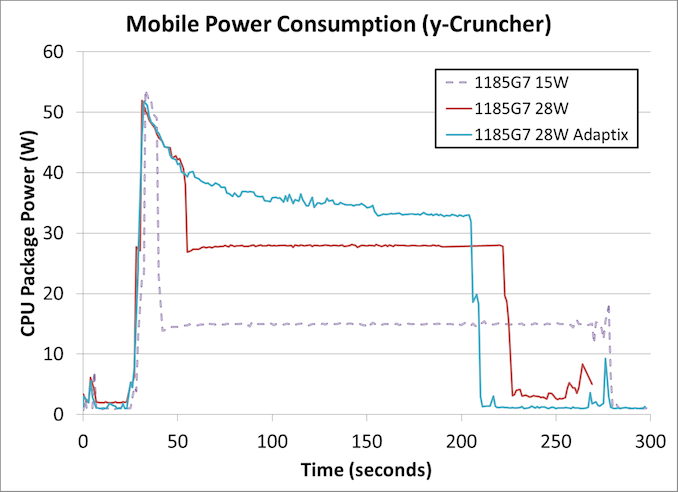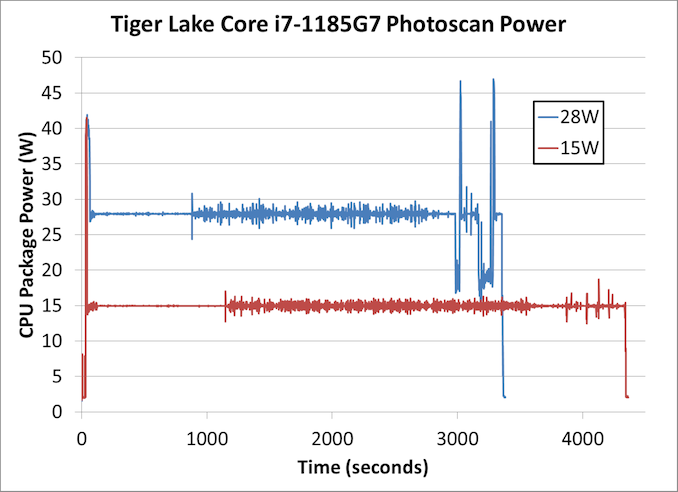Intel’s Tiger Lake 11th Gen Core i7-1185G7 Review and Deep Dive: Baskin’ for the Exotic
by Dr. Ian Cutress & Andrei Frumusanu on September 17, 2020 9:35 AM EST- Posted in
- CPUs
- Intel
- 10nm
- Tiger Lake
- Xe-LP
- Willow Cove
- SuperFin
- 11th Gen
- i7-1185G7
- Tiger King
Comparing Power Consumption: TGL to TGL
On the first page of this review, I covered that our Tiger Lake Reference Design offered three different power modes so that Intel’s customers could get an idea of performance they could expect to see if they built for the different sustained TDP options. The three modes offered to us were:
- 15 W TDP (Base 1.8 GHz), no Adaptix
- 28 W TDP (Base 3.0 GHz), no Adaptix
- 28 W TDP (Base 3.0 GHz), Adaptix Enabled
Intel’s Adaptix is a suite of technologies that includes Dynamic Tuning 2.0, which implements DVFS feedback loops on top of supposedly AI-trained algorithms to help the system deliver power to the parts of the processor that need it most, such as CPU, GPU, interconnect, or accelerators. In reality, what we mostly see is that it reduces frequency in line with memory access stalls, keeping utilization high but reducing power, prolonging turbo modes.
Compute Workload
When we put these three modes onto a workload with a mix of heavy AVX-512 compute and memory accesses, the following is observed.
Note that due to time constraints this is the only test we ran with Adaptix enabled.
This is a fixed workload to calculate 2.5 billion digits of Pi, which takes around 170-250 seconds, and uses both AVX-512 and 11.2 GB of DRAM to execute. We can already draw conclusions.
In all three power modes, the turbo mode power limit (PL2) is approximately the same at around 52 watts. As the system continues with turbo mode, the power consumed is decreased until the power budget is used up, and the 28 W mode has just over double the power budget of the 15 W mode.
Adaptix clearly works best like this, and although it initially follows the same downward trend as the regular 28 W mode, it levels out without hitting much of a ‘base’ frequency at all. Around about the 150 second mark (120 seconds into the test), there is a big enough drop followed by a flat-line which would probably indicate a thermally-derived sustained power mode, which occurs at 33 watts.
The overall time to complete this test was:
- Core i7-1185G7 at 15 W: 243 seconds
- Core i7-1185G7 at 28 W: 191 seconds
- Core i7-1185G7 at 28 W Adaptix: 174 seconds
In this case moving from 15 W to 28 W gives a 27% speed-up, while Adaptix is a total 40% speed-up.
However, this extra speed does come at the cost of total power consumed. With most processors, the peak efficiency point is when the system is at idle, and while these processors do have a good range of high efficiency, when the peak frequencies are requested then we are in a worst case scenario. Because this benchmark measures power over time, we can integrate to get total benchmark power consumed:
- Core i7-1185G7 at 15 W: 4082 joules
- Core i7-1185G7 at 28 W: 6158 joules
- Core i7-1185G7 at 28 W Adaptix: 6718 joules
This means that for the extra 27% performance, an extra 51% power is used. For Adaptix, that 40% extra performance means 65% more power. This is the trade off with the faster processors, and this is why battery management in mobile systems is so important - if a task is lower priority and can be run in the background, then that is the best way to do it to conserve battery power. This means things like email retrieval, or server synchronization, or thumbnail generation. However, because users demand the start menu to pop up IMMEDIATELY, then user-experience events are always put to the max and then the system goes quickly to idle.
Professional ISV Workload
In our second test, we put our power monitoring tools on Agisoft’s Photoscan. This test is somewhat of a compute test, split into four algorithms, however some sections are more scalable than others. Normally in this test we would see some sections rely on single threaded performance, while other sections use AVX2.
This is a longer test, and so the immediate turbo is less of a leading factor across the whole benchmark. For the first section the system seems content to sit at the respective TDPs, but the second section shows a more variable up and down as power budget is momentarily gained and then used up immediately.
Doing the same maths as before,
- At 15 W, the benchmark took 4311 seconds and consumed 64854 joules
- At 28 W, the benchmark took 3330 seconds and consumed 92508 joules
For a benchmark that takes about an hour, a +30% performance uplift is quite considerable, however it comes at the expense of +43% power. This is a better ratio than the first compute workload, but still showcases that 28 W is further away from Tiger Lake’s ideal efficiency point.
Note that the power-over-time graph we get for Agisoft on a mobile processor looks very different to that of a desktop processor, as a mobile processor core can go above the TDP budget with fewer threads.
This leads to the dichotomy of mobile use cases with respect to the marketing that goes on for these products - as part of the Tiger Lake launch, Intel was promoting its use for streaming, professional workflows such as Adobe, video editing and content creation, and AI acceleration. All of these are high-performance workloads, compared to web browsing or basic office work. Partly because Tiger Lake is built on the latest process technology, as well as offering Intel’s best performing CPU and GPU cores, the product is going to be pitched in the premium device market for the professionals and prosumers that can take advantage.












253 Comments
View All Comments
JfromImaginstuff - Friday, September 18, 2020 - link
Intel is planning to release a 8 core 16 thread SKU, confirmed by one of their management can't remember his name but when that'll reach the market is a question markRedOnlyFan - Friday, September 18, 2020 - link
With the space and power constraints you can choose to pack more cores or other features that are also very important.So Intel chose to add 4c + the best igpu + AI + neural engine + thunderbolt + Wi-Fi 6 + pcie4.
Amd chose 8cores and a decent igpu.
So we have to choose between raw power and more useful package.
For a normal everyday use an all round performance is more important. There are millions who don't even know what cinebench is for.
Spunjji - Friday, September 18, 2020 - link
Weird that you're calling it "the best iGPU" when the benchmarks show that it's pretty much equivalent to Vega 8 in most tests at 15W with LPDDR4X, which is how it's going to be in most notebooks.Funny also that you're proclaiming PCIe 4 to be a "useful feature" when the only thing out there that will use it in current notebooks is the MX450, which obviates that iGPU.
I could go on but really, Thunderbolt is the only one I'd say is a reasonable argument. A bunch of AMD laptops already have Wi-Fi 6
JayNor - Saturday, September 19, 2020 - link
but Intel has lpddr5 support built in. Raising memory data rate by around 25% is something that should show up broadly as more performance in the benchmarks.Intel's Tiger Lake Blueprint Session benchmarks were run with lpddr4x, btw, so expect better performance when lpddr5 laptops become available.
https://edc.intel.com/content/www/us/en/products/p...
Spunjji - Saturday, September 19, 2020 - link
I understand and agree. My point was, what does "support" matter if it's not actually useable in the product? This will be an advantage when devices with it release. Right now, it's irrelevant.abufrejoval - Friday, September 18, 2020 - link
I'd say going for the biggest volume market (first).Adding cores costs silicon real-estate and profit per wafer and the bulk of the laptop market evidently doesn't want to pay double for eight cores at 15 Watts.
Being a fab, Intel doesn't seem to mind doing lots of chip variants, for AMD it seems to make more sense to go for volume and fewer variants. The AMD 8 core APU covers a lot of desktop area, but also laptops, where Intel just does distinct 8 core chip.
Intel might even do distinct iGPU variants at higher CPU cores (not just via binning), because the cost per SoC layout is calculated differently.... at least as long as they can keep up the volumes.
I'm pretty sure they had a lot of smart guys run the numbers, doesn't mean things might not turn out differently.
Drumsticks - Thursday, September 17, 2020 - link
Regarding:Compromises that had been made when increasing the cache by this great of an amount is in the associativity, which now increases from 8-way to a 20-way, which likely increases conflict misses for the structure.
On the L3 side, there’s also been a change in the microarchitecture as the cache slice size per core now increases from 2MB to 3MB, totalling to 12MB for a 4-core Tiger Lake design. Here Intel was actually able to reduce the associativity from 16-way to 12-way, likely improving cache line conflict misses and improving access parallelism.
---
Doesn't increasing cache associativity *decrease* conflict misses? Your maximum number of conflict misses would be a direct mapped cache, where everything can go into only one place, and your minimum number of conflict misses would be a fully associative cache, where everything can go everywhere.
Also, isn't it weird that latency increases with the reduced associativity of the new L3? I guess the fact that it's 50% larger could have a larger impact, but I'd have thought reducing associativity should improve latency and vice versa, even if only slightly.
Drumsticks - Thursday, September 17, 2020 - link
Later on, there is:The L2 seemingly has gone up from 13 cycles to 14 cycles in Willow Cove, which isn’t all that bad considering it is now 2.5x larger, even though its associativity has gone down.
---
But in the table, associativity is listed as going from 8 way to 20 way. Is something mixed up in the table?
AMDSuperFan - Thursday, September 17, 2020 - link
How does this compare with Big Navi? It seems that Big Navi will be much faster than this right?Spunjji - Friday, September 18, 2020 - link
🤡